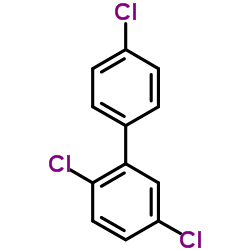Genomic damage induced in tobacco plants by chlorobenzoic acids--metabolic products of polychlorinated biphenyls.
Tomas Gichner, Petra Lovecka, Blanka Vrchotova
文献索引:Mutat. Res. 657(2) , 140-5, (2008)
全文:HTML全文
摘要
Tobacco seedlings (Nicotiana tabacum var. xanthi) were treated for 24 h with mono-(2- and 3-CBA), di-(2,5- and 3,4-CBA), and tri-(2,4,6- and 2,3,5-CBA)-chlorobenzoic acids (CBAs) and with the mixture of polychlorinated biphenyls--Delor 103, or cultivated for 1 or 2 weeks in soil polluted with the CBAs. DNA damage in nuclei of leaves and roots was evaluated by the comet assay. A significant increase in DNA damage was observed only at concentrations of CBAs that caused withering of leaves or had lethal effects within 2-4 weeks after the treatments. As the application of CBAs did not induce somatic mutations, the induced DNA migration is probably caused by necrotic DNA fragmentation and not by DNA damage resulting in genetic alteration. In contrast, the application of the monofunctional alkylating agent ethyl methanesulphonate as a positive control resulted in a dose-response increase of DNA damage and an increase of somatic mutations. Thus, the EMS-produced DNA migration is probably associated with genotoxin-induced DNA fragmentation. The data demonstrate that the comet assay in plants should be conducted together with toxicity studies to distinguish between necrotic and genotoxin-induced DNA fragmentation. The content of 2,5-CBA in tobacco seedlings was measured by reverse-phase high pressure liquid chromatography.
相关化合物
| 结构式 | 名称/CAS号 | 分子式 | 全部文献 |
|---|---|---|---|
 |
2,4',5-三氯联苯
CAS:16606-02-3 |
C12H7Cl3 |
|
Liver cell cytoplasmic inclusions in experimental porphyrias...
1997-08-01 [Exp. Toxicol. Pathol. 49(3-4) , 289-93, (1997)] |
|
Alteration of regiospecificity in biphenyl dioxygenase by ac...
2002-07-01 [J. Bacteriol. 184(13) , 3682-8, (2002)] |
|
Impacts of molt-inhibiting organochlorine compounds on epide...
2009-11-01 [Comp. Biochem. Physiol. C. Toxicol. Pharmacol. 150(4) , 436-41, (2009)] |
|
Microcosm experiments to assess the effects of temperature a...
2005-12-15 [Environ. Sci. Technol. 39(24) , 9517-22, (2005)] |
|
The impact of particulates on the aqueous sonication of brom...
2002-01-01 [Chemosphere 46(1) , 59-66, (2002)] |